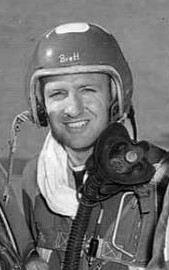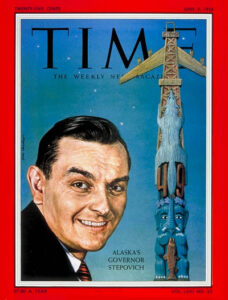In the June 9, 1958 edition of TIME Magazine, there was an article titled “How To Go Weightless”. “The magazine’s Medicine Editor Gilbert Cant “went weightless in one of the Air Force’s fast jet fighters piloted by LtCol Devol “Rock” Brett, skipper of the 355th Fighter Squadron and son of World War II’s Lieut. General George H. Brett.”(1)
LtCol Devol “Rock” Brett, skipper of the 355th Fighter Squadron and son of World War II’s Lieut. General George H. Brett.”(1)
 The editor’s account of the flight reads:
The editor’s account of the flight reads:
“AT 500 knots the F-100F Super Sabre pulled out of its dive and rocketed upward. Up went the needle on the accelerometer or “g meter,” which gauges the piling up of gravity forces. In a “g suit” hooked up to an automatic air-compressor system, I felt a giant’s fist pressing into my belly, two pairs of giant hands around my thighs and calves, to retard the flow of blood to the feet and reduce the risk of blackout. Belatedly I remembered to try the “M1 maneuver”—tensing the abdominal muscles to reduce the blood drainage still more. The g-meter needle crept up past 2 to 3 and on to 4. My normal 145 lbs. now weighed 580: I felt compressed, depressed. Even the light rubber ball of the pneumatic release for my camera shutter, held in my hand, seemed unbearably heavy. With the eyeballs tugged downward, with eyelids feeling like rusty iron curtains, it was an intense effort to peek “up” to keep watching the meters.
As we approached the peak of our climb, the relentless 4-g pressure was lifted and suddenly we slipped through a man-made loophole in the law of gravity: we weighed nothing at all.”
The article continues to tell of Cant’s experience in the Super Sabre.
“A few minutes out of Langley, our Super Sabre whooshed over Virginia’s Dismal Swamp to the cirrus-dappled air over North Carolina’s Chowan River. This area was set aside for acrobatics, cleared of other aircraft. In the Super Sabre, Brett could have wafted into weightlessness by flying high and level, faster than sound, and pushing the plane’s nose up into the Keplerian trajectory, in which centrifugal force exactly cancels the earth’s gravitational pull. Despite his plane’s vast speed reserve, he chose to work at lower altitudes, enter the parabola from a power dive (see diagram). Over “hot mikes” (both microphones always switched on, so that each of us could hear the other’s breathing), he asked simply: “Ready?”
Like a Lead Balloon. Gripped in my hand as we went through the power-dive and pullout was a 4-oz. lead sinker of the kind used by bottom fishermen. Though it cost only 7¢ at the base PX, it made a far more vivid indicator of the zero-gravity state than the electronic accelerometer in which the Air Force has invested millions. As my bottom, squeezed to insensible bloodlessness during the 4-g pullout, rose from the seat cushion, I felt the exhilaration of restored circulation (and noted the lasting aptness of the old barnstormer’s motto: you fly by the seat of your pants). I “dropped” the sinker in front of my masked face. It stayed there, floating. The merest delicate touch sent it gliding, featherlike, right or left, up or down, forward or aft. I was as happy as I would have been with a stringless yoyo. This was one place where a lead balloon would make a hit.
It was over too soon. Pilot Brett had been too busy with his controls and indicators, and I had been too bemused by the otherworldliness of the phenomenon, to time our first excursion into weightlessness. Colonel Brett pulled up the nose again, regained altitude, and within a minute or so was asking: “Ready to try it again?” Down we dived and up into another pullout. Up went the g needle. I felt a crushing force, and then the ineffable relief of sub gravity and the euphoria of zero gravity. This time it lasted longer. Again I toyed with the stringless yoyo, so delightedly that I did not notice when we began to slow down. By inertial force, the sinker glided forward from my upraised left hand. My grab for it was defeated by the shoulder harness. Over the hot mike, I warned Brett: “There’s a lead slug corning over your left shoulder.” He looked up, saw the sinker gliding past his head in slow motion, bided his time, and coolly upped the plane’s nose. The movement dropped the sinker gently into his lap. As he passed it back, he also gave me a short piece of string, with an invitation to use it.” (1)
Source: (1) Time Magazine, June 9, 1958. To read the full article go to Medicine: HOW TO GO WEIGHTLESS – TIME
For more info on Devol “Rock” Brett, see his bio page at Brett, Carroll Devol – Super Sabre Society
